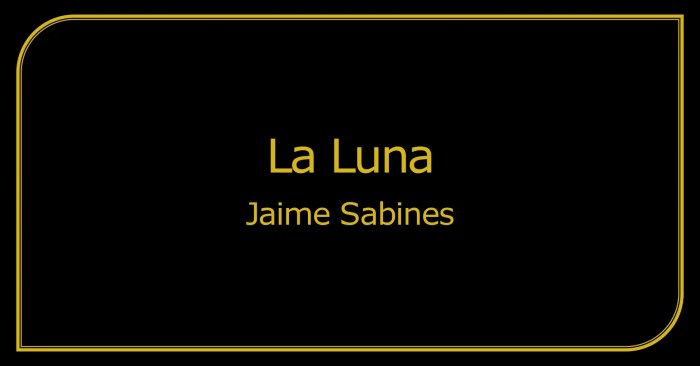La luna jaime sabines english, a captivating poem by Jaime Sabines, invites readers to delve into its profound themes and masterful use of language. This exploration unveils the significance of the moon as a symbol, the literary devices employed, and the poem’s broader cultural context.
The poem’s central themes of love, loss, and longing resonate deeply with Sabines’ other works, providing a glimpse into his unique perspective on the human experience.
La Luna by Jaime Sabines: An Overview: La Luna Jaime Sabines English

“La Luna” is a renowned poem by Jaime Sabines, a distinguished Mexican poet. It stands as a poignant reflection on the human condition, exploring themes of solitude, longing, and the search for meaning in a vast and indifferent universe.
Historical and Cultural Context, La luna jaime sabines english
“La Luna” emerged during a period of significant social and political change in Mexico. The mid-20th century witnessed a growing sense of disillusionment and existentialism, as the country grappled with the aftermath of the Mexican Revolution. Sabines’ poetry captured the mood of the era, expressing a profound sense of alienation and a longing for connection amidst a rapidly modernizing society.
Literary Devices and Techniques

Jaime Sabines’ “La Luna” employs a range of literary devices to evoke a vivid and evocative poetic experience. These devices include metaphors, similes, and imagery, all of which contribute to the poem’s profound meaning and impact.
Metaphors
- The moon as a “corpse”: This metaphor compares the moon to a dead body, suggesting its lifeless and distant nature.
- The moon as a “blind eye”: This metaphor likens the moon to a sightless organ, conveying its inability to perceive or understand.
Similes
- The moon is “like a white pearl”: This simile compares the moon to a precious gemstone, highlighting its beauty and luminosity.
- The moon’s light is “like a white cloth”: This simile compares the moon’s illumination to a soft and ethereal fabric, evoking its gentle and comforting nature.
Imagery
Sabines’ use of imagery is particularly striking in “La Luna.” He paints vivid pictures that engage the reader’s senses and create a lasting impression:
- Visual imagery: The poem’s opening line, “La luna, un cadáver” (The moon, a corpse), immediately conjures a powerful visual image of a lifeless moon.
- Tactile imagery: The line “Su luz es como un paño blanco” (Its light is like a white cloth) invites the reader to imagine the soft and comforting touch of moonlight.
- Auditory imagery: The poem’s final line, “Y oigo su silencio” (And I hear its silence), creates a sense of auditory emptiness that amplifies the moon’s enigmatic and distant nature.
Language and Rhythm
The language and rhythm of “La Luna” contribute to its overall impact. Sabines uses simple and direct language, yet his choice of words is precise and evocative. The poem’s rhythm is unhurried and contemplative, reflecting the moon’s slow and steady movement across the night sky.
The enchanting poetry of “La Luna” by Jaime Sabines explores the mysteries of the moon, its ethereal glow, and its profound impact on our emotions. For those seeking a different path, a free NYS notary practice exam awaits, offering an opportunity to delve into the legal realm.
Returning to the moon’s embrace, Sabines’ words continue to captivate, reminding us of the celestial wonder that illuminates our nights and inspires our imaginations.
Symbolism and Interpretation

The moon is a powerful symbol in the poem, and it can be interpreted in many different ways. On one level, the moon represents the natural world and its cycles. It is a symbol of time and change, and it can also represent the human experience of life and death.
The Moon as a Symbol of the Natural World
The moon is often associated with the natural world, and it can be seen as a symbol of the cycles of life and death. The moon waxes and wanes, and it can also represent the changing seasons. In the poem, the moon is described as “a white flower” and “a silver coin.”
These images suggest that the moon is a beautiful and valuable part of the natural world.
The Moon as a Symbol of the Human Experience
The moon can also be interpreted as a symbol of the human experience. The moon is often associated with emotions, and it can represent the human experience of love, loss, and longing. In the poem, the moon is described as “a lost love” and “a broken heart.”
These images suggest that the moon can represent the pain and suffering that we all experience in life.
The Moon as a Symbol of Hope
Despite its association with pain and suffering, the moon can also be a symbol of hope. The moon is a source of light in the darkness, and it can represent the hope that we all have for a better future.
In the poem, the moon is described as “a new beginning” and “a promise of tomorrow.” These images suggest that the moon can represent the hope that we all have for a better future.
Themes and Motifs

Jaime Sabines’ “La Luna” explores several profound themes and motifs that resonate throughout his body of work. These include:
Love and Loss
The poem revolves around the speaker’s longing for a lost love, expressing the pain and anguish of loss. Sabines deftly captures the emotions of unrequited love, the yearning for what is unattainable, and the sense of emptiness left behind. This theme of loss and longing is a recurring motif in Sabines’ poetry, often intertwined with the theme of love.
Memory and Nostalgia
The poem is infused with a sense of nostalgia and the power of memory. The speaker recalls past moments with his lost love, painting vivid images that evoke both longing and a bittersweet sense of longing. Sabines’ use of evocative language and sensory imagery transports the reader into the speaker’s memories, creating a deeply personal and emotionally resonant experience.
Nature and Symbolism
Sabines employs rich symbolism throughout the poem, drawing upon natural imagery to convey the speaker’s emotions and experiences. The moon, a recurring motif in Sabines’ work, becomes a symbol of longing, unattainability, and the cyclical nature of life and loss.
The speaker’s connection to the natural world serves to both intensify and transcend his personal pain.
Comparative Analysis

Jaime Sabines’ “La Luna” exhibits distinct characteristics that set it apart from his other works and those of other poets. However, comparative analysis reveals intriguing similarities and differences that enrich our understanding of the poem.
Similarities
Sabines’ poems often explore themes of love, loss, and the human condition. “La Luna” shares these themes with works like “Algo sobre la muerte del mayor Sabines” and “Yuria.” The speaker’s grief and longing are palpable in all three poems, evoking a sense of universal human experience.
Stylistically, Sabines employs simple, direct language that conveys raw emotions. This is evident in “La Luna” and “El Gallo,” where short, unadorned sentences create a sense of immediacy and authenticity.
Differences
Despite these similarities, “La Luna” stands out for its unique perspective. While other poems by Sabines often focus on personal experiences, “La Luna” takes a broader view, addressing the universal human longing for connection and the transience of life.
In terms of impact, “La Luna” has resonated deeply with readers due to its relatable themes and evocative imagery. It has become an iconic poem in Mexican literature, while other works by Sabines may be more obscure or niche.
Comparative Analysis
Comparative analysis of “La Luna” with other poems enhances our understanding of its significance. The similarities highlight Sabines’ consistent exploration of universal human themes and his distinctive writing style. The differences showcase the poem’s unique perspective and its broad appeal.
Through these comparisons, we gain a deeper appreciation for Sabines’ artistry and the enduring power of “La Luna” as a reflection of the human experience.
FAQ Corner
What is the significance of the moon in “La Luna”?
The moon serves as a powerful symbol of love, loss, and longing, reflecting the emotional journey of the speaker.
How does Sabines use literary devices in the poem?
Sabines employs metaphors, similes, and vivid imagery to create a rich sensory experience that enhances the poem’s emotional impact.
What are the major themes explored in “La Luna”?
The poem delves into themes of love, loss, longing, and the human condition, capturing the complexities of the human experience.